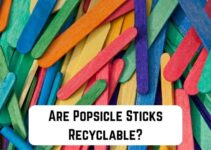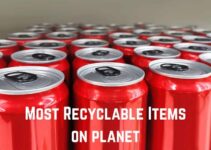You are probably already familiar with Mylar if you have used metallic balloons during a birthday celebration or other event. It is a robust substance frequently utilized in party balloons, cracker or chip bags, cookie packing, candy wrappers, and other items.
Most homes have balloons and mylar bags, and many people use them without considering their long-term effects on the environment. However, can you recycle Mylar or not? Dive in to find out!
What is Mylar?
DuPont manufactures a particular kind of plastic film under the trade name Mylar. “Mylar Film” and “Biaxially-Oriented Polypropylene Film” are other names for them. A single layer of this film is made of polyester resin, and the other is made of propylene.
The film’s outstanding structural stability is made possible by its multilayer composition. This mix makes it ideal for a wide range of uses. Mylar is typically used to package goods and keep them fresh.
It has great resistance to a wide range of temperatures, which makes it perfect for products that need sturdy packaging. The Mylar bag is sealed when you buy stuff, preventing air from entering or escaping.
This material differs from numerous other plastics in one important way. This indicates that it possesses plastic-like qualities. On the other hand, there is still some disagreement about whether it qualifies as plastic.
It is just a different kind of plastic with different characteristics. As a result, the recycling procedures are distinct from those used for other kinds of plastic. Mylar is employed as a thermal and electrical insulator, as well as a decorative material and reflector.
Are Mylar Bags Recyclable?
The majority of recycling programs do not accept mylar bags. This is because they are made up of PET plastic and aluminum. Even though each of these elements is recyclable, recycling Mylar bags is challenging since the two materials need to be kept apart.
Many recycling facilities need more tools to achieve this or need help to afford them. Reusing an item has always been the best alternative for recycling. Repurposing the object is the second-best choice.
Mylar is a good insulator because of its reflective properties; NASA uses it in their space outfits and emergency blankets. When considering that mylar bags are reusable, their environmental impact is relatively low.
Reusing a mylar bag results in fewer natural resources than would be needed to create a brand-new storage bag.
On another hand, these bags will require an extended period to disintegrate in landfills due to the strong materials they are constructed of and the difficulties in recycling them.
Let us examine how Mylar bags are used for preparation and storage, particularly in food. Since Mylar is food-grade safe and ideal for storing dry and low-fat foods, including flour, grains, and beans, it is the recommended storage choice.
This food saver shields food from water and gas, notably oxygen, and is less susceptible to gasses compared to other polymers. When utilized as a laminate, it preserves nutritious and fresh food; some items, when preserved properly in Mylar bags, can last up to 25 years.
Are Mylar Balloons Recyclable?
The synthetic plastic used to make mylar balloons is recyclable but does not decompose. Make sure to recycle them with other recyclable plastics because they will not live forever in landfills.
Mylar balloons are a colorful and enjoyable way to mark special occasions, but getting rid of them after use can be difficult. Mylar balloons can be recycled through certain communities’ usual curbside recycling programs, while many others do not.
Fortunately, there are ways to recycle mylar balloons using plastic bags and dispose of them responsibly. The greatest alternative to discarding is saving Mylar balloons to be re-inflated later.
Mylar balloons are delicate, so handle them gently. After pressing out the leftover helium, keep the balloons flat so they may be re-inflated when needed. Despite being a common party element, mylar balloons significantly negatively influence the environment due to their extended lifespan.
Contrarily, latex balloons normally degrade within six months, while mylar balloons might take up to four years to do so. Mylar has a metallic sheen because it is constructed of plastic resin instead of metal.
It stays in the atmosphere for a long period after it has decomposed as a result. Therefore, it is essential to think carefully before releasing Mylar balloons into the atmosphere and to consider how they may affect the environment.

Challenges in Mylar Recycling
Mylar is difficult to recycle. Almost always, metallic balloons intended to bring “joy and happiness” to a birthday or other special occasion end up in the water or landfills. Plastic Mylar is not biodegradable.
For two main reasons, most neighborhood recycling facilities either need more capacity to recycle Mylar or opt not to. First, this lightweight plastic easily gets trapped in recycling equipment, which can cause many issues, including an interruption in the recycling process.
In addition, Mylar balloons are “multi-layered,” which refers to joining a metallic foil layer and a plastic layer. The two layers are extremely difficult for waste management facilities to separate, making recycling the Mylar material either impossible or prohibitively expensive.
Mylar can only be recycled via Terracycle. A company called TerraCycle specializes in recycling difficult-to-recycle materials. They accept various kinds of materials, including Mylar, that are too complicated to recycle.
Buy a recycling container from the business and stuff it with the Mylar products. You can arrange for free shipping of the box back to TerraCycle for recycling. It is encouraging that organizations like Terracycle are leading the charge to recycle Mylar.
It represents a significant advance toward a greener environment. Many customers must know Mylar is not recyclable at their neighborhood recycling facilities. This could result in a hazardous buildup of substances that could endanger the surroundings and living things.
Alternatives To Mylar
Mylar bags are among the finest ways to increase the shelf life of goods, but there are many situations in which they may need to be more appropriate for you. There are additional alternatives to increase the lifespan of your food storage, whether they are more expensive or are simply unavailable where you reside.
Below are the alternatives to using products made from Mylar.
Mason Jars
Mason jars are available practically anywhere in the world, so these are fantastic possibilities. Better yet, if you can locate oxygen absorbers, if oxygen absorbers are unavailable but a vacuum seal connection is available, use that to remove the air. Mason jars should be kept in a dark cupboard, container, or bucket because they are frequently clear.
Paper Chains
Paper chains are a more eco-friendly alternative to balloons for decorating. Creating lengthy chains and displaying them in garlands adds brightness and cheer to any space.
They are easy to produce, and you may make decorations that will cover the entire room rapidly. You may even involve the whole family and have the kids help with the decorating because the procedure is so simple.
Paper is compostable and recyclable, so you can eliminate paper chains without harming the environment after you are done with them. By recycling paper or utilizing paper you previously have, you may build paper chains that are even more environmentally beneficial.
Vacuum Sealer
In most parts of the world, this seems to be something that is more easily accessible. The majority of food varieties will operate just as well when vacuum sealed. Not even an oxygen absorber is required. Since most bags are transparent, be sure to put them in a container or box to keep them out of the light.
Bubbles
Blowing bubbles is an even less wasteful alternative to confetti for generating that “celebratory air.” You prepare your solution using water, glycerin, and eco-friendly dishwashing soap, and you help kids fashion their magic wands from leftover pipe cleaners.
Alternatively, purchase a prepared eco-bubble solution or, for a greater impact, purchase or lease bubble-blowing equipment.
Ways To Dispose of Mylar Products
Mylar bags can be disposed of in a relatively limited number of ways. The only method to get rid of them is to throw them away because they cannot be recycled or degraded through most recycling programs.
Make sure to safeguard any waste bags to ensure they can arrive at the landfill because if you discard them, they will likely wind up in the water or a landfill.
The best course of action is to try to reuse them for as many years as possible because throwing them in the trash is also not ideal. Mylar should only be disposed of properly or used once because it cannot be recycled.
Here are some suggestions for how to reuse mylar products to prevent their disposal in landfills.
- Utilize while creating artwork, such as posters and scrapbooks.
- Deflate it, keep it carefully, and then use it again as a balloon by adding helium.
- Trim it to size to use as present wrapping, or use many pieces of Mylar for larger gifts.
Conclusion
Mylar bags are not environmentally friendly because they are constructed of aluminum and PET plastic film. Additionally, they are not biodegradable, difficult to recycle, and can produce microplastics.
Mylar bags have the advantages of being strong, recyclable, and oxygen- and moisture-resistant. However, there are superior substitutes for Mylar bags that are more eco-friendly in particular fields and have similar characteristics.






